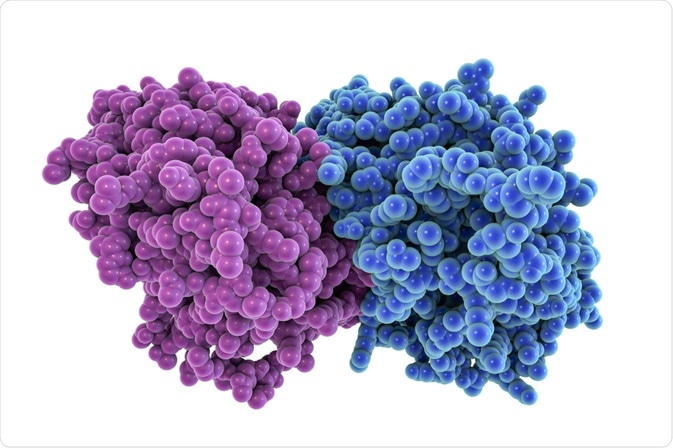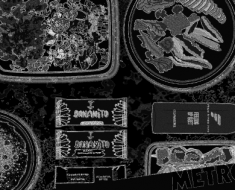In molecular biology, the term tubulin can refer to the protein superfamily or a specific protein within that family.

Image Credit: Kateryna Kon/Shutterstock.com
The tubulin family of proteins are vital components of the eukaryotic cytoskeleton and are the main constituent of microtubules in living cells.
The tubulin proteins α- and β polymerize into long chains or filaments that form microtubules, an essential element of the eukaryotic cytoskeleton. These microtubules play a crucial role in cell support and cell movement, making tubulin imperative to normal cell function.
As well as serving an essential role in the structure and basic operation of cells, tubulin has also been identified as a potential novel therapeutic approach for cancer treatment.
Microtubules
Structural support, intracellular support, and DNA segregation are provided to eukaryotic cells by α- and β-tubulin, polymerized into microtubules. These structures are formed of rigid hollow, fibrous shafts of the globular protein, tubulin, that measure around 25 nm in diameter. The α- and β tubulins are encoded by small families of related genes and combine to form a dimer that the microtubules are constructed from.
Along with actin, microtubules are an essential component of the cytoskeleton, and they serve to determine a cell’s shape as well as its movements. Microtubules are vital to processes such as cell locomotion, separating chromosomes during mitosis, and the intracellular transportation of organelles. They also make up the internal structure of cilia and flagella.
Cell support
One major function of the microtubules that are built by tubulin is that they form the cytoskeleton of eukaryotic cells together with microfilaments and intermediate filaments. They are part of a team of components that provide the structure, shape, and internal organization of a cell. The specific structural role of microtubules is that they help the cell resist compression forces, and therefore enable it to maintain its intended shape and structure.
Cell movement
Through being a fundamental component of the cell’s cytoskeleton, tubulin is also crucial to the cell’s interaction with other organelles, and its movement. The cytoskeleton connects to every part of the cell membrane and every organelle. Tubulin and other filaments are known to be responsible for the movement of the cell membrane, organelles, and cytoplasm.
Types of tubulin
There are six known proteins that make up the tubulin superfamily in eukaryotes, however, not all six are consistently present across eukaryote species. In addition, many prokaryotic proteins have been identified as being related to tubulin. For a long time tubulin was considered specific to eukaryotes, but recent developments have proved this to be untrue.
In humans, there are five subgroups of tubulin: α-Tubulin, β-Tubulin, γ-Tubulin, δ and ε-Tubulin, and ζ-Tubulin. β-Tubulin is of particular interest because it forms a type of microtubule that is expressed exclusively in neurons.
Also, all drugs that bind to human tubulin also bind to β-tubulin, making it of interest as a therapeutic target. On the other hand, γ-Tubulin is known to be responsible for the nucleation and polar orientation of microtubules.
The proteins that have been identified in prokaryotes include BtubA/B, FtsZ, TubZ, and CetZ.
Applications in cancer treatment
There is a mounting body of research to support tubulin’s role in the development of new therapeutic drugs, particularly for anticancer drugs. Currently, a number of anticancer drugs are in existence that target tubulins, such as vinblastine, vincristine, and paclitaxel.
The anti-gout agent colchicine has also been found to impact on tubulin, binding to the protein and inhibiting microtubule formation, having the impact of decreasing inflammation. This drug has been linked with a decreased risk of prostate and colorectal cancers.
Further to this, there is evidence to show that griseofulvin, an anti-fungal drug, targets microtubule formation and is associated with the inhibition of proliferation of various types of cancer cells and inhibition of tumor growth.
Current research is looking further into how new anticancer therapies can be developed by targeting tubulins and the microtubules that they create.
They are of particular interest because they are known to be related to the dynamics of the mitotic spindle, which is associated with mitotic arrest and cell death. This is different to most other chemotherapeutic cancer drugs that act on DNA.
At this point, more research into tubulin and microtubules and their role in cancer is required to access the full potential they pose to the development of novel therapeutic approaches for the treatment of cancer.
A focus of these future developments will likely be on minimizing the adverse side effects that are related with the use of tubulin targeted drugs, such as stomatitis, nausea, vomiting, diarrhea, constipation, paralytic ileus, urinary retention, bone marrow suppression, musculoskeletal effects, severe weakness, hypotension, alopecia, and more.
There are also a number of limitations of this kind of drug therapy that continued research is likely to focus on overcoming. Future work will hope to improve antitumor activity, toxicity profile, and drug formulation.
Sources:
- Cooper, G. (2019). Microtubules. [online] Ncbi.nlm.nih.gov. Available at: https://www.ncbi.nlm.nih.gov/books/NBK9932/ [Accessed 23 Nov. 2019].
- D. Katsetos, C. and Draber, P. (2012). Tubulins as Therapeutic Targets in Cancer: from Bench to Bedside. Current Pharmaceutical Design, 18(19), pp.2778-2792. https://www.ncbi.nlm.nih.gov/pubmed/22390762
- Hammond, J., Cai, D. and Verhey, K. (2008). Tubulin modifications and their cellular functions. Current Opinion in Cell Biology, 20(1), pp.71-76. https://www.ncbi.nlm.nih.gov/pmc/articles/PMC2274889/
- Parker, A., Kavallaris, M. and McCarroll, J. (2014). Microtubules and Their Role in Cellular Stress in Cancer. Frontiers in Oncology, 4. https://www.ncbi.nlm.nih.gov/pmc/articles/PMC4061531/
Further Reading
- All Cellular Biology Content
- Structure and Function of the Cell Nucleus
- What Are Organelles?
- Ribosome Structure
- Protein Production: Initiation, Elongation and Termination
Last Updated: Feb 6, 2020

Written by
Sarah Moore
After studying Psychology and then Neuroscience, Sarah quickly found her enjoyment for researching and writing research papers; turning to a passion to connect ideas with people through writing.
Source: Read Full Article





